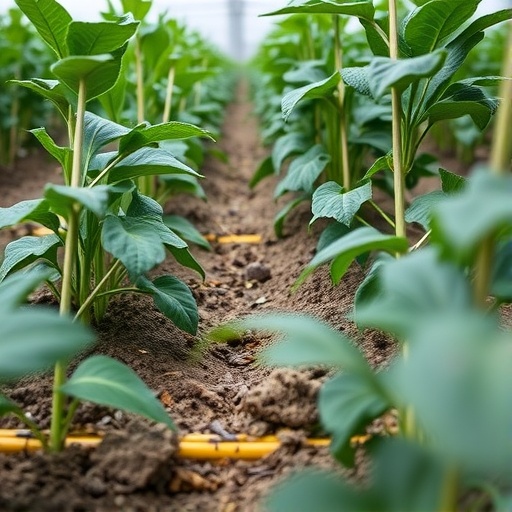In the continuous battle between crops and their microscopic adversaries, the arsenal of pathogens is evolving in extraordinary ways. Beyond visible threats such as aphids and grasshoppers, invisible enemies like bacteria pose significant risks to global agriculture. The pervasive bacterium Pseudomonas syringae, notorious for its ability to devastate plants including tomato crops, has been the subject of groundbreaking research shedding light on how it subverts plant biology. This new insight into bacterial manipulation of plants could pave the way for revolutionary crop protection strategies.
Researchers at Washington University in St. Louis have uncovered a sophisticated mechanism that P. syringae employs to hijack the plant’s intrinsic signaling systems, turning its own biology into a weapon against itself. Central to this discovery is the bacterium’s ability to eavesdrop on the plant hormone auxin, a vital compound regulating growth and environmental response in virtually all land plants. By detecting fluctuations in auxin production, P. syringae can gauge the success of its invasion and accordingly amplify its aggressive attack.
Auxin is a cornerstone hormone in plant physiology, orchestrating processes from cellular elongation to stress adaptation. Its role extends into modulating the plant’s immune responses, making it a critical node in the plant’s defense network. The discovery that bacterial pathogens can intercept this signal reveals an added layer of complexity in the plant-pathogen interaction paradigm, underscoring an evolutionary arms race at the molecular level.
The investigative team focused on Arabidopsis thaliana, a model organism in plant biology from the mustard family, to elucidate this interaction in exquisite detail. Through meticulous genetic and molecular analyses, they pinpointed a bacterial protein named PmeR that is able to sense auxin-associated compounds. This sensory capability triggers a cascade of gene expression changes in the bacteria, effectively enhancing their virulence factors and enabling them to better survive and proliferate within the plant tissues.
The protein PmeR acts as a molecular receptor, detecting not auxin directly but a chemically related molecule associated with the hormone’s activity. This indirect sensing mechanism allows P. syringae to monitor the plant’s physiological state covertly. Upon detection, PmeR activates virulence-related genes that bolster the pathogen’s infection machinery, effectively coordinating a more potent assault.
The implications of this finding are profound. Traditionally, control of bacterial plant diseases relies on chemical treatments or breeding for resistant crop varieties. However, targeting essential plant hormones like auxin is impractical due to their fundamental roles in plant development. Instead, the strategy illuminated by this research aims at disrupting the pathogen’s ability to perceive the hormone, essentially rendering the bacteria “blind” to the plant’s biochemical signals.
To translate this concept into a viable solution, the Washington University researchers are collaborating with specialists in structural biology to characterize the three-dimensional architecture of the PmeR protein. Understanding its structural nuances is critical for designing molecules that could competitively inhibit PmeR’s ligand binding domain or otherwise interfere with its sensory function. Such specialized compounds could serve as novel agrochemicals, applied externally to fields, to disarm bacterial pathogens without affecting the plant’s own hormonal balance.
This approach exemplifies a precision strategy in crop protection, targeting pathogen perception rather than direct toxicity. By confusing the bacteria’s molecular “senses,” it may be possible to reduce virulence and infection success, thereby limiting crop losses caused by bacterial diseases. Future studies will need to explore the specificity, efficacy, and environmental safety of such potential treatments to ensure they are sustainable and non-disruptive to ecosystems.
The study also highlights the complex dialogue that occurs at the microscopic interface between plants and bacteria. Far from being straightforward antagonists, their communication is mediated by finely tuned chemical and molecular exchanges. This sophistication emphasizes that plant immunity and pathogen strategies co-evolve continually, an idea that shapes modern approaches to agricultural biotechnology.
While the battle against Pseudomonas syringae and similar bacterial pathogens is far from over, the discovery of their auxin sensing mechanism marks a significant milestone. It opens unprecedented avenues for intervention that are less reliant on traditional pesticides and more grounded in molecular biology and biochemistry. Such innovations hold promise not only for protecting vital food crops but also for advancing our understanding of plant-microbe interactions on a fundamental level.
As researchers deepen their exploration into these signaling pathways, there remains much to uncover about how widespread this auxin sensing capability is among other plant-associated bacteria. Determining whether similar mechanisms are at play in different pathogen species could extend the relevance of this research broadly across agriculture, potentially transforming plant disease management worldwide.
In the grand tapestry of life sciences, this research weaves together themes of molecular biology, evolutionary biology, microbiology, and plant biochemistry. It exemplifies how detailed molecular insights can yield innovative solutions to age-old challenges in food security, reaffirming the importance of interdisciplinary collaboration in modern science.
The Washington University team’s work was recently published in the esteemed journal mBio, signaling the significance of this advancement to the scientific community. Though practical applications remain in development, the foundations laid by this study inspire optimism that future technologies will leverage the subtle interplay between plants and their microscopic invaders to safeguard crops more effectively than ever before.
Subject of Research: Bacterial sensing of plant hormone auxin in Pseudomonas syringae
Article Title: (Not provided)
Web References: https://journals.asm.org/doi/10.1128/mbio.01152-25
References: (Not provided)
Image Credits: (Not provided)
Keywords: Life sciences, Plant biochemistry, Molecular biology, Evolutionary biology, Microbiology




